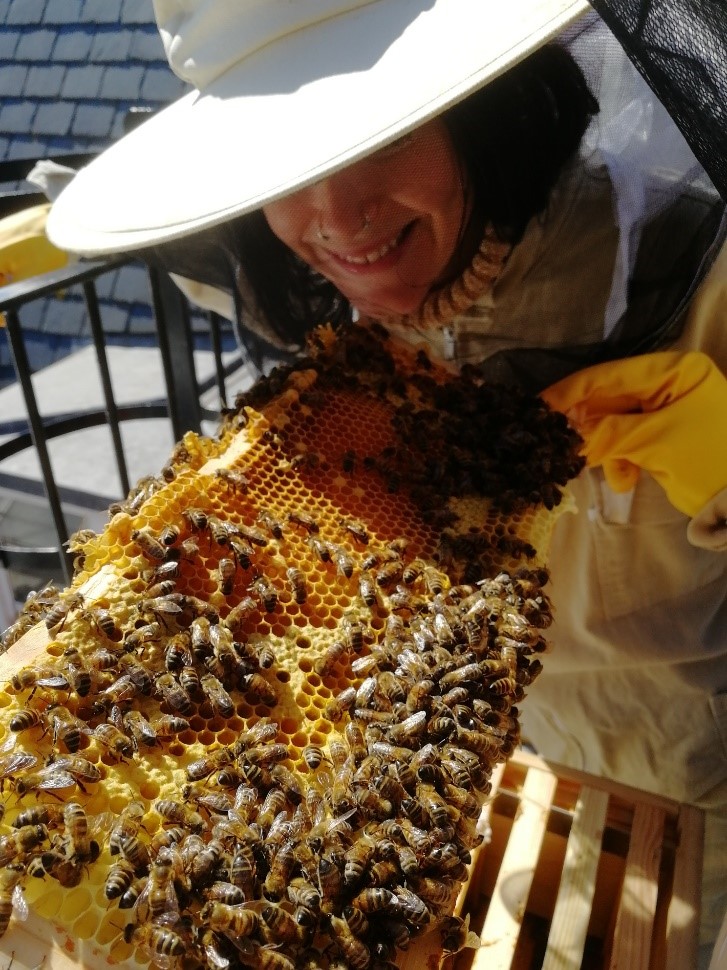
Darllenwch yr erthygl yma yn Gymraeg | View this post in Welsh
August 2019
The Assembly’s Pierhead building has been the home of two rooftop beehives since July 2018, regularly monitored and cared for by a small team of staff volunteers.
Despite having a rooftop location the hives are in a safe, sheltered spot which gives them protection from the worst of Cardiff Bay's weather. Under the watchful eyes of our volunteers they settled in through autumn and survived their first winter.
Now it’s summer again, the bees are working hard and have started producing honey.
Here, some of our volunteers talk about their experiences:
Emily
It’s the height of summer and the Pierhead Bees are busier than ever foraging the surrounding areas of the Pierhead to build up stores of their glorious golden honey.
Whilst one of the hives had a relatively slow start this summer, the bees have more than made up for it and have now built up frame after frame of honey which will be harvested in the Autumn. It never ceases to amaze me just how hard working the bees are… To make just 1KG of honey, our Pierhead bees will have flown 145, 000km and could have visited up to 2000 flowers per day! As you can see from the photos below, they have been very busy indeed.
So how do the bees make honey? Our bees have been busy foraging the local area for nectar found in plants and wildflowers. The nectar is collected, then once inside the beehive, the worker bees repeatedly consume, digest and regurgitate the nectar into the cells. When it is the right consistency, the honey is then sealed which is what you can see in the photos below.
This will be the first season where we will be able to harvest honey, and as a new beekeeper I am excited to see the process. Honey has been harvested for thousands of years for its various benefits. Not only does it taste delicious and never goes off, but it has many medicinal properties too. It is anti-bacterial and anti-inflammatory and can even be used to help relieve hay fever symptoms. Hopefully the bees will be kind enough to share some of their honey with us later in the year!
Did you know?
Honey stores have been found in the tombs of ancient Egyptian Pharaohs and when excavated were still edible 3000 years later! Proving the theory that honey never goes off!


Sian D
As a nature lover, I feel very lucky to be part of such an exciting project at the Assembly.
Who knew that there was so much to learn about bees?! I’ve been working on the project for just over a year now and I still find myself constantly learning about their ways and tricks. I’m nearly always surprised each time I lift the lid off a hive and peer in - particularly at the astonishing speed with which the hives change and develop.
The busy nature of the bees means that it is essential that we carry out weekly inspections during the summer months, while the flowers are blooming and pollination activity is in full swing. We work as a pair during the inspections, thoroughly scanning each frame as we work our way through the hive. While we scan we look for honey (their food supply); pollen; capped brood cells; larva; eggs; and the usually inconspicuous queen.
During an inspection you may find some of the bees raising their behinds in the air and frantically fanning their wings. If you are brave enough to put your face close to them then you will smell a lovely fresh scent of lemon being wafted up your nostrils. This scent that they release helps the foraging bees find their way home.
As you scan through the hives you will also find that the capped cells come in different sizes. The large raised ones will contain a drone bee (male) and the flatter cells contain a smaller female bee.
Did you know that the queen bee can choose the sex of its offspring? When a virgin queen first leaves the hive she will have multiple matings with drone bees during her flight. She then stores the sperm using it bit by bit as she lays her eggs. Her stores will usually last around three years. If she fertilizes an egg with sperm then a female bee will emerge, and a drone will emerge from an unfertilized egg. This ‘choice’ is determined by the size of the brood cells made by the worker bees. And these are only a few of the many fascinating facts about the wondrous bees!
Sian C
I jumped at the opportunity to be involved in the bee keeping here at the Assembly and my experience so far has not disappointed.
The bee keeping is fascinating and I find the time spent up on top of the Pierhead so relaxing. Caring for the bees and watching the hives grow and change has been an education, and I am in awe of the colonies and the way in which nature works.
I have learnt so much, not just about the bees, but also it has further peaked my interest in environmental issues and from this I have made some big changes to my consumer habits, diet and garden! Not only have I learnt a new skill, I have also met some amazing new people from all walks of Assembly life, many of whom I wouldn’t have had a chance to speak with beyond a quick ‘hello’ in the corridor.
Thanks for the opportunity to be part of such an innovative project - I love it!
Katy
I am always surprised to see the letters ‘Dr.’ in front of my name. But I am a doctor. Not the type you’d want on a plane when the stewards shout ‘is there a doctor on-board?!’ for I am (what my friends have coined) a ‘Dr of Bees’. My PhD was based on studying wild pollinators which involved identifying bee species and the flowers they feed on.
So, I was so excited to discover that the Assembly had started keeping bees. I am now a member of the Bee team (by no means secondary) and it is such a privilege. Although I had studied wild pollinator communities, I didn’t have any experience of keeping honey bees. I have learned so much from Nature’s Little Helpers and my fellow Bee team colleagues, thank you for the opportunity.
They are amazing animals. They truly work as a ‘hive mind’, each having specialised roles depending on their age, which they perform so diligently. The youngest bees are the cleaners. They progress through the roles of feeding their larval brothers and sisters, building the combs, guarding the hive and finally flying away to collect pollen and nectar.
Together they create the most meticulous and astonishing collective. And of course there is the Queen. But she doesn’t reign as you might imagine, for it is the worker bees that call the shots. Through cues, they control the queen’s activity - they even decide whether she lays a male or female grub!

Due to their rooftop location and not wanting to disturb the bees, the hives are not open to the public, although if you look carefully you might spot one of them gathering pollen around Cardiff Bay.


